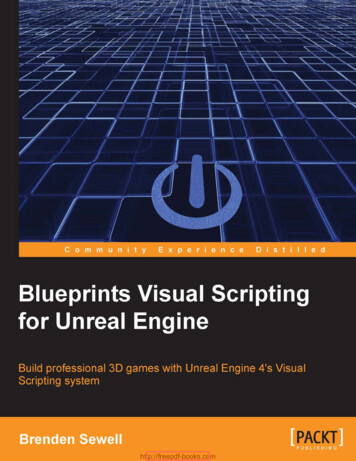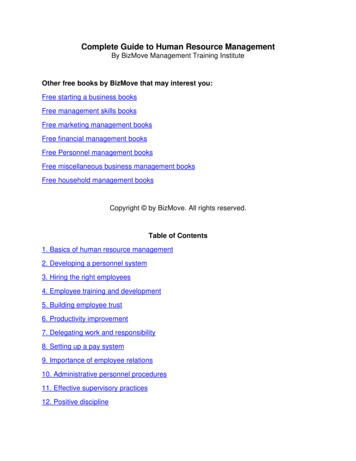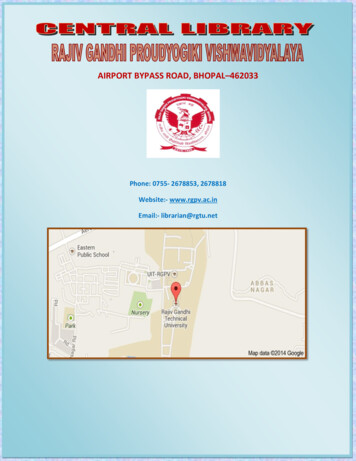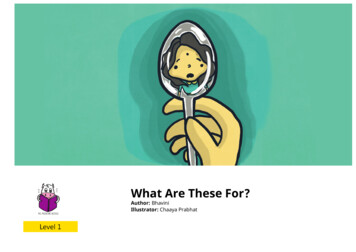
Transcription
http://freepdf-books.com
Blueprints Visual Scriptingfor Unreal EngineBuild professional 3D games with Unreal Engine 4'sVisual Scripting systemBrenden SewellBIRMINGHAM - MUMBAIwww.allitebooks.comhttp://freepdf-books.com
Blueprints Visual Scripting for Unreal EngineCopyright 2015 Packt PublishingAll rights reserved. No part of this book may be reproduced, stored in a retrievalsystem, or transmitted in any form or by any means, without the prior writtenpermission of the publisher, except in the case of brief quotations embedded incritical articles or reviews.Every effort has been made in the preparation of this book to ensure the accuracyof the information presented. However, the information contained in this book issold without warranty, either express or implied. Neither the author, nor PacktPublishing, and its dealers and distributors will be held liable for any damagescaused or alleged to be caused directly or indirectly by this book.Packt Publishing has endeavored to provide trademark information about all of thecompanies and products mentioned in this book by the appropriate use of capitals.However, Packt Publishing cannot guarantee the accuracy of this information.First published: July 2015Production reference: 1210715Published by Packt Publishing Ltd.Livery Place35 Livery StreetBirmingham B3 2PB, UK.ISBN omhttp://freepdf-books.com
CreditsAuthorCopy EditorsBrenden SewellHiral BhatVikrant PhadkeReviewersFaris AnsariProject CoordinatorScott HafnerNeha BhatnagarMarcin KamińskiAlankar PradhanMatt SutherlinCommissioning EditorNeil AlexanderAcquisition EditorVivek AnantharamanContent Development EditorDivij KotianProofreaderSafis EditingIndexerRekha NairProduction CoordinatorAparna BhagatCover WorkAparna BhagatTechnical EditorAnushree Arun om
About the AuthorBrenden Sewell is a lead game designer at E-Line Media, and has spent the last 5years designing and creating games that are both fun to play and have educational orsocial impact. He has been building games since 2002, when Neverwinter Nights taughthim an invaluable lesson about the expressive power of game design. In 2010, hegraduated with a degree in cognitive science from Indiana University. Since then, hehas focused on enhancing his own craft of game design while harnessing its power todo good in the world, and exposing more people to the joy the profession holds.I would like to thank the following people for contributing to thisbook and making it a reality: Steve Swink (@steveswink), JakeMartin, Demetrius Comes, and Graeme Bayless for providing me theright mentorship to elevate me in my design practice; Logan Barnett(@logan barnett) and David Koontz (@dkoontz) for pushing myknowledge of scripting to become a more versatile developer; thePackt Publishing staff and my technical reviewers for helping meto make this book a reality; the Unreal development communityfor being supportive and informative as we all endeavor to masterthis technology together; and my supremely supportive girlfriendMichelle, my parents who made this all possible, and all of myincredible friends for enriching my life.www.allitebooks.comhttp://freepdf-books.com
About the ReviewersFaris Ansari is an IT professional from Pakistan, who has skills and interest inUnity 3D, Unreal Engine, Cocos2d, the Allegro library, OpenGL, and other gamedevelopment environments. He started his career as a game developer and workedon successful games that generated huge revenues. He also possesses the skillsrequired for, and takes on new challenges while, working on new technologies,especially open source technologies.Faris has reviewed the book Learning NGUI for Unity.His hobbies consist of playing games, learning new things, and watching movies.He is very interested in working with fellow coworkers and friends on innovativeideas. His favorite saying is, "Every professional was once a beginner."Feel free to contact him and discuss something innovative. He can be reached onLinkedIn at https://www.linkedin.com/in/farisansari.I would like to thank my friends and family for their continuoussupport and help.Scott Hafner is a professional game designer with over 10 years of experience inthe video game industry. Over the course of his career, he has worked as a producer,game designer, and level designer on a range of platforms and genres, includingMMOs, third-person shooters, and RPGs.I would like to thank my fianceé for her continued encouragementand support in all that I do!www.allitebooks.comhttp://freepdf-books.com
Marcin Kamiński is working for CTAdventure as a senior programmer andhas his own company, Digital Hussars. Previously, he worked for Artifex Mundi,CI Game, and Vivid Games. His main fields of expertise are artificial intelligenceand network programming. For 14 years, he has helped develop great gamesfor PCs, consoles, and mobiles.Marcin was also a reviewer of the books Unity iOS Essentials and Unity 2D GameDevelopment Cookbook.Alankar Pradhan hails from Mumbai, Maharashtra. He did his schooling fromI.E.S.'s CPV High School. He is an ambitious person who loves interacting withnew people, dancing, kickboxing, traveling, spending leisure time with friends, andplaying games on PCs and mobiles. Games have always been a passion in his life.More than just playing games, how things worked was his main curiosity. Hence, hedecided to pursue his career in this. Alankar completed his BSc honors in softwaredevelopment from Sheffield Hallam University, UK. He has done his master'sin video game programming and management (video game director; BAC 5equivalent) from DSK Supinfogame, where he undertook industry-oriented projectsto increase his skill sets and gave his best to do so. Alankar worked as a gameprogramming intern at Walt Disney, India. During his internship, he was workingon a live project called Hitout Heroes. His name was added to the credits due to hisnoticeable work accomplished. He also interned as a game programmer with DSKGreen Ice Games, and then went on to work as a video game programmer on a gametargeted at PCs and consoles. This game, Death God University (D.G.U), was releasedon July 1, 2015. Another project he is working on is The Forsaken Mountains.Alankar has worked on many small projects in teams as well as individually tosharpen his own skills in various languages, such as C#, C , Java, Unreal scripting,Python, Lua, Groovy/Grails, HTML5/CSS and so on. He is familiar with enginessuch as Unity3D, Unreal Development Kit, and Visual Studio and SDKs such asNetBeans, Eclipse, and Wintermute. In 2013, his dissertation work on Comparisonbetween Python and Lua in Gaming Industry got published as a book. He has workedwith Packt Publishing previously as a technical reviewer of Creating E-LearningGames With Unity and Learning Unreal Engine iOS Game Development.Other than this, Alankar likes to read, listen to music, and write poems and shortstories at times. He has his own website at http://alan.poetrycraze.com, wherehe posts his poems. He has also published a book, The Art Of Lost Words, which isavailable on .com
His e-mail ID is alankar.pradhan@gmail.com. You can visit his portfolio siteat alankarpradhan.wix.com/my-portfolio or contact him on Facebook atwww.facebook.com/alankar.pradhan.We are so often caught up in our aim that we forget to appreciatethe journey, especially the people we meet on the way. Appreciationis a wonderful feeling, and it's way better if we don't overlook it.I hereby like to take this opportunity to acknowledge the peoplewho directed me and inspired me in this initiative.I would like to express my sincere thanks to my parents, who alwaysinstilled and believed in me. I am also thankful to my friends fortheir constant support and encouraging words that helped mereach this level.Last but not least, I would like to thank all the people who aredirectly or indirectly involved in this book and helped me insome way or another.Matt Sutherlin has been working in the games industry over the lastdecade, where he's served roles ranging from a QA and scripter to an engineprogrammer and a technical artist. Most recently, he has had a strong focus ongraphics technology, working on engine renderers, art pipelines, and shadersfor AAA titles such as Heroes of the Storm and Halo 5: Guardians.I would like to thank my wife, Megan, and parents, Mike and MaryLynn, for years of support, patience, and understanding; I wouldn'tbe where I am without you. I'd also like to thank Alan Wolfe forbeing an unending stream of cool programming tricks and insightfulalgorithms and for generally being a really great friend.www.allitebooks.comhttp://freepdf-books.com
www.PacktPub.comSupport files, eBooks, discount offers, and moreFor support files and downloads related to your book, please visit www.PacktPub.com.Did you know that Packt offers eBook versions of every book published, with PDFand ePub files available? You can upgrade to the eBook version at www.PacktPub.com and as a print book customer, you are entitled to a discount on the eBook copy.Get in touch with us at service@packtpub.com for more details.At www.PacktPub.com, you can also read a collection of free technical articles, signup for a range of free newsletters and receive exclusive discounts and offers onPackt books and ion/packtlibDo you need instant solutions to your IT questions? PacktLib is Packt's online digitalbook library. Here, you can search, access, and read Packt's entire library of books.Why subscribe? Fully searchable across every book published by Packt Copy and paste, print, and bookmark content On demand and accessible via a web browserFree access for Packt account holdersIf you have an account with Packt at www.PacktPub.com, you can use this to accessPacktLib today and view 9 entirely free books. Simply use your login credentials forimmediate access.www.allitebooks.comhttp://freepdf-books.com
Table of ContentsPrefaceChapter 1: Object Interaction with BlueprintsCreating a project and the first levelSetting a template for a new projectMaking sense of the project settingsCreating the projectAdding objects to our levelExploring materialsCreating materialsMaterial properties and Blueprint nodesAdding substance to our materialCreating our first BlueprintExploring the Event Graph panelDetecting a hitSwapping a materialImproving the BlueprintAdding movementChanging actor mobility and collisionBreaking down our goalStoring data with variablesReadying direction for calculationsGetting relative speed using delta timeTranslating the existing locationUpdating locationChanging directionTesting moving 627
Table of ContentsChapter 2: Enhancing Player Abilities29Chapter 3: Creating Screen UI Elements47Chapter 4: Creating Constraints and Gameplay Objectives63Adding the running functionality by extending a BlueprintBreaking down the Blueprint character movementCustomizing control inputsAdding a sprint abilityAnimating a zoom viewUsing a timeline to smooth transitionsIncreasing the projectile's speedAdding sound and particle effectsGiving our targets state with branchesTriggering sound effects, explosions, and destructionSummaryCreating simple UI meters with UMGDrawing shapes with widget BlueprintsCustomizing the meter's appearanceCreating ammo and enemy countersDisplaying the HUDConnecting UI values to player variablesCreating bindings for health and staminaMaking text bindingsTracking the ammo and eliminated targetsReducing the ammo counterIncreasing the targets eliminated counterSummaryConstraining player actionsDraining stamina while sprintingUsing looping timers to repeat actionsBlocking actions with branchesRegenerating staminaPreventing firing actions when out of ammoCreating collectable objectsSetting up collection logicSetting a gameplay win conditionDisplaying a target goal in the HUDCreating a win menu screenDisplaying the menuTriggering a winSummary[ ii 8505253555557595960616464676970717272767677798081
Table of ContentsChapter 5: Making Moving Enemies with AISetting up the enemy actor to navigateImporting from the marketplaceExpanding the play areaMaking the level traversable with a NavMeshSetting the stage for intelligence with AI assetsCreating navigation behaviorSetting up patrol pointsEnabling communication between assetsTeaching our AI to walk with the Behavior TreeMaking the AI chase the playerGiving the enemy sight with Pawn SensingAdding conditions to the Behavior TreeCreating chasing ter 6: Upgrading the AI Enemies103Chapter 7: Tracking Game States and ApplyingFinishing Touches129Creating an enemy attackMaking an attack taskUpdating the health meterMaking enemies hear and investigate soundsAdding hearing to the Behavior TreeSetting up the investigating tasksInterpreting and storing the noise event dataAdding noise to the player's actionsMaking the enemies destructibleSaving time by reusing existing Blueprint contentSpawning more enemies during gameplayChoosing a spawn point where enemies will appearManaging spawn rates and limits with variablesSpawning new enemies in the Level BlueprintCreating enemy wandering behaviorIdentifying a wander point with a custom taskAdding wandering to the Behavior TreeSummaryMaking danger real with player deathSetting up a lose screenCreating round-based scaling with saved gamesStoring game information using a SaveGame object[ iii 15116118118119121124125126128129130133133
Table of ContentsStoring and loading the saved data when starting the gameIncreasing the enemy target goalCreate a transition screen to be shown between roundsTransitioning to a new round when the current round is wonPausing the game and resetting the save fileCreating a pause menuResuming and resetting the save fileTriggering the pause menuSummary134138139141143144145147149Chapter 8: Building and Publishing151Index163Optimizing your graphics settingsSetting up our game to be played by othersPackaging the game into a buildSteps for further learningFinish and share as many games as you canStretch out of your comfort zoneResources for additional learning and supportSummary[ iv ]http://freepdf-books.com151154158159159160160161
PrefaceGame engines, such as Unreal Engine 4—as the tools that power the creation ofthe commercial games we love to play—are becoming increasingly accessible toboth experienced and novice game developers outside of the traditional studioenvironment. Previous versions of Unreal Engine have powered many of the mostpopular console and PC games released over the last decade, and the newest versioncontains the tools for funneling this power into the hands of as many aspiringdevelopers as possible. The most transformative of these tools is the BlueprintsVisual Scripting system, which allows people who are not full-time programmersto create and implement the mechanics, interfaces, and interactions of a game.Taking a step-by-step approach, this book will guide you through the process ofusing the visual nodes that make up Blueprint behavior, and link them togetherto create game mechanics, user interfaces, and more. In this process, you will belearning all the skills you need to get started with developing games in UnrealEngine 4 using Blueprints.Starting with a basic first-person shooter template, each chapter will extend theprototype to create an increasingly complex and robust game experience. You willprogress from creating basic shooting mechanics to gradually more complex systemsthat will generate user interface elements and intelligent enemy behavior. By focusingon universally applicable skills, the expertise you will develop in utilizing Blueprintscan translate to other types of genres. By the time you finish this book, you will have afully functional first-person shooter and the skills necessary to expand on the game todevelop an entertaining, memorable experience for your players.[v]http://freepdf-books.com
PrefaceWhat this book coversChapter 1, Object Interaction with Blueprints, begins the book by covering how to bringnew objects into a level to help build the world in which the game will be set. Wemove on to manipulating materials on objects, first through the object editor, andthen by triggering during runtime via Blueprints.Chapter 2, Enhancing Player Abilities, teaches you how to use Blueprints to generatenew objects during gameplay, and link actions in Blueprints to player control inputs.You also learn to create Blueprints that allow objects to react to collisions with ourgenerated projectiles.Chapter 3, Creating Screen UI Elements, demonstrates setting up a Graphical UserInterface (GUI) that will track the player's health, stamina, ammo, and currentobjective. Here, you learn how to set up a basic user interface using Unreal's GUIeditor and how to use Blueprints to link the interface to the gameplay values.Chapter 4, Creating Constraints and Gameplay Objectives, covers how to constrain theplayer's abilities, define the gameplay objectives for a level, and track those objectivesvia Blueprints that interact with the GUI elements created in the previous chapter.We walk through setting up collectible ammo packs that will refill the ammo of theplayer's gun, as well as utilizing the level Blueprint to define a win condition forour game.Chapter 5, Making Moving Enemies with AI, is a crucial chapter that covers how tocreate an enemy zombie AI that will pursue the player around the level. We walkthrough setting up a navigation mesh on our level, and see how to use Blueprintsto get enemies to traverse between patrol points.Chapter 6, Upgrading the AI Enemies, shows how to create a compelling experienceby modifying the zombie AI to have states in order to give the zombies a little moreintelligence. In this chapter, we set up the patrol, searching, and attack states for thezombies using visual and auditory detection. Additionally, we explore how to makenew enemies appear gradually, as the game is playing.Chapter 7, Tracking Game States and Applying Finishing Touches, adds the finishingtouches necessary to make our game a complete experience, before we finalizeour game for release. In this chapter, we create rounds that will make the gameincreasingly difficult, game saves so that the player can save their progress andreturn, and player death to make the game's challenge meaningful.Chapter 8, Building and Publishing, covers how to optimize graphics settings to get ourgame performing and looking at its best. Then, we explain how to create a sharablebuild of the game, and share some advice on how to continue progressing past theconfines of this book on your way to becoming an accomplished game developer![ vi ]http://freepdf-books.com
PrefaceWhat you need for this bookThis book is an Unreal Engine 4-focused title, which means you only need a copyof Unreal Engine to get started. Unreal Engine 4 can be downloaded for free fromhttps://www.unrealengine.com/, and comes with everything you need to followalong with the book. This book was made using version 4.7.6 of Unreal Engine 4,and as such, it does not account for features added or removed in subsequentversions of the software.Who this book is forWhether you are brand new to game development or just unexposed to UnrealEngine 4's Blueprint Visual Scripting system, this is a great place to start learninghow to build complex game mechanics quickly and easily without writing anytext code. No programming experience required!ConventionsIn this book, you will find a number of text styles that distinguish between differentkinds of information. Here are some examples of these styles and an explanation oftheir meaning.Code words in text, database table names, folder names, filenames, file extensions,pathnames, dummy URLs, user input, and Twitter handles are shown as follows:"I named the project BlueprintScripting and stored it in the default UnrealProjects folder for OS X."New terms and important words are shown in bold. Words that you see on thescreen, for example, in menus or dialog boxes, appear in the text like this: " Nowclick on the Library tab, find the yellow Install button (as seen in the followingscreenshot), and click on it."Warnings or important notes appear in a box like this.Tips and tricks appear like this.[ vii ]http://freepdf-books.com
PrefaceReader feedbackFeedback from our readers is always welcome. Let us know what you think aboutthis book—what you liked or disliked. Reader feedback is important for us as ithelps us develop titles that you will really get the most out of.To send us general feedback, simply e-mail feedback@packtpub.com, and mentionthe book's title in the subject of your message.If there is a topic that you have expertise in and you are interested in either writingor contributing to a book, see our author guide at www.packtpub.com/authors.Customer supportNow that you are the proud owner of a Packt book, we have a number of thingsto help you to get the most from your purchase.Downloading the example codeYou can download the example code files from your account at http://www.packtpub.com for all the Packt Publishing books you have purchased. If youpurchased this book elsewhere, you can visit http://www.packtpub.com/supportand register to have the files e-mailed directly to you.Downloading the color images of this bookWe also provide you with a PDF file that has color images of the screenshots/diagrams used in this book. The color images will help you better understand thechanges in the output. You can download this file from ads/6018OT ColoredImages.pdf.ErrataAlthough we have taken every care to ensure the accuracy of our content, mistakesdo happen. If you find a mistake in one of our books—maybe a mistake in the text orthe code—we would be grateful if you could report this to us. By doing so, you cansave other readers from frustration and help us improve subsequent versions of thisbook. If you find any errata, please report them by visiting http://www.packtpub.com/submit-errata, selecting your book, clicking on the Errata Submission Formlink, and entering the details of your errata. Once your errata are verified, yoursubmission will be accepted and the errata will be uploaded to our website oradded to any list of existing errata under the Errata section of that title.[ viii ]http://freepdf-books.com
PrefaceTo view the previously submitted errata, go to https://www.packtpub.com/books/content/support and enter the name of the book in the search field. The requiredinformation will appear under the Errata section.PiracyPiracy of copyrighted material on the Internet is an ongoing problem across allmedia. At Packt, we take the protection of our copyright and licenses very seriously.If you come across any illegal copies of our works in any form on the Internet, pleaseprovide us with the location address or website name immediately so that we canpursue a remedy.Please contact us at copyright@packtpub.com with a link to the suspectedpirated material.We appreciate your help in protecting our authors and our ability to bring youvaluable content.QuestionsIf you have a problem with any aspect of this book, you can contact us atquestions@packtpub.com, and we will do our best to address the problem.[ ix ]http://freepdf-books.com
http://freepdf-books.com
Object Interactionwith BlueprintsWhen setting out to develop a game, one of the first steps toward exploring youridea is to build a prototype. Fortunately, Unreal Engine 4 and Blueprints make iteasier than ever to quickly get the essential gameplay functionality working so thatyou can start testing your ideas sooner. To develop some familiarity with the Unrealeditor and Blueprints, we will begin by prototyping simple gameplay mechanicsusing some default assets and a couple of Blueprints.In this chapter, we will cover the following topics: Creating a new project and a level Placing objects in a level Changing an object's material through Blueprints Using the Blueprint editor and connecting Blueprints together Compiling, saving, and playing our game Moving objects in the world with BlueprintsCreating a project and the first levelBefore we can begin setting up gameplay elements, we need to create a project thatwill contain the content of our game. To access Unreal Engine 4 and begin setting upour project, we must first open the Epic Games Launcher, which can be downloadedfrom the Unreal Engine 4 website (https://www.unrealengine.com/). From theEpic Games Launcher, click on the tab labeled Unreal Engine. If you are usingUnreal Engine on your computer for the first time, you will see a grayed out-buttonlabeled Not Installed. Along the left-hand side of the launcher, you will see .com
Object Interaction with BlueprintsThe Library tab is the location where you will be able to access the versions of theengine you have installed and the projects you have built. Now click on the Librarytab, find the yellow Install button (as seen in the following screenshot), and clickon it:When the engine has finished installing, the Install buttons will change to Launchbuttons, as shown in the following screenshot. Click on any of the Launch buttonsto open the engine.[2]http://freepdf-books.com
Chapter 1Setting a template for a new projectOnce you click on Launch, you will be presented with the Unreal Project Browser.This will by default take you to the Projects tab, which will show you a thumbnailview of all the projects you have created, as well as any sample projects you mightchoose to install. For our purposes, we want to start a new project, so click on thetab labeled New Project.From the New Project tab, you can select a template that will give you the initialassets to use for your game; or you can choose to start a blank project. You will seetwo subtabs under the New Project tab, labeled Blueprint and C . Creating aproject from the content within the Blueprint tab will start your project with a basicset of behavior built using Blueprints. The C tab is used to create projects whereat least some of the core types of behavior of the game are going to be built using theC programming language. Since we quickly want to get a prototype first-personshooter up and running without having to build the basic controls from scratch, weshould ensure that we have the tab labeled Blueprint selected. Then we choose theFirst Person template, as shown here:[3]http://freepdf-books.com
Object Interaction with BlueprintsMaking sense of the project settingsThe next step is to adjust the project settings to our liking. The three gray boxesbelow the template selector allow us to select the class of hardware we are targeting(desktop/console or mobile/tablet), the graphics scalability, and whether we want tocreate our project with or without starter content. Leave these settings at their defaultvalues (Desktop/Console, Maximum Quality, and With Starter Content). Belowthese, you will see a folder path field used to designate where you would like to storeyour project on your hard drive, and a name field to input the name by which yourproject will be known. I named the project BlueprintScripting and stored it in thedefault Unreal Projects folder for OS X, as shown in this screenshot:Creating the projectNow that we have a template selected and the project settings set up the way we like,we can create the project. To do so, click on the green Create Project button. After theengine is done with initializing the assets and setting up your project, Unreal Editorwill open Level Editor, where you can create and view levels, place and modifyobjects, and test your game as you modify it.Pressing the Play button, as shown in the following screenshot, along the top of thetoolbar, will allow you to try the default gameplay that comes built into the FirstPerson template. This includes player movement, shooting a simple projectile, andusing projectiles to apply force to primitive box objects. In play mode, the Playbutton will be replaced with a Pause button and a Stop button. You can press thePause button to temporarily halt the play session, which can be useful when youwant to explore the properties of an interaction or actor that you just encounteredduring gameplay. Pressing the Stop button will end the play session and take youback to editing mode. Go ahead and try playing the game before we continue.[4]http://freepdf-books.com
Chapter 1Adding objects to our levelNow we want to start adding our own objects to the level. The central panel yousee in Level Editor is known as 3D Viewport. A viewport allows you to see the 3Dcontent of the game, and it is important that you become familiar with navigatinginside this panel. The viewport can be navigated by moving the camera aroundusing a combination of mouse buttons and its movement. Holding down the leftmouse button and dragging the mouse pointer inside the viewport moves the cameraview forward and backward, or left and right. Holding down the right mouse buttonand moving the mouse allows you to look around by rotating the camera. Finally,holding down either the middle mouse button or a combination of both the left andright mouse buttons will allow you to drag the camera up and down.The simplest kind of object that can be dragged into the game world in Unreal Engine4 is called an actor. An actor is a basic object with no inherent behavior other thanthe ability to be rotated, moved, and scaled, but it can be expanded to include morecomplex behavior by attaching components. Our goal w
hails from Mumbai, Maharashtra. He did his schooling from I.E.S.'s CPV High School. He is an ambitious person who loves interacting with new people, dancing, kickb










